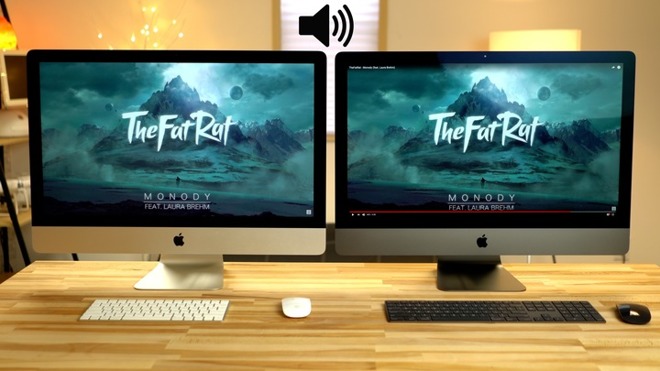Mar 20, 2020 The MacBook Air vs. The MacBook Pro The closest Apple alternative to the MacBook Air is the entry-level 13-inch MacBook Pro, which tips the scales at 3.02 pounds. In return for a slightly higher.
Imac Vs Macbook Pro
Some high-end professional Mac users are frustrated, and they have been for years.
The current Mac Pro received a lukewarm reception when it began shipping in 2013, and it has been preserved in amber ever since. The MacBook Pro went with few substantial updates for a long period of time after 2012. And when Apple overhauled its video editing software and released Final Cut Pro X in 2011, many editors were turned off by its compromises.
Imac Vs Mac Pro For Gaming Laptop
But things are definitely looking up: 2016 brought a strong refresh of the MacBook Pro lineup, and Final Cut Pro X has gradually been updated to address and exceed most professionals’ expectations, including a significant release this past December that improved the color tools and added full support for HEVC and 360 video.
Now, the Mac desktop is in focus. In April of last year, Apple invited press to discuss its plans for pro desktops, but it didn’t have specific products to announce at that time. This was a surprise, as Apple usually does not discuss its plans for products unless they are close to being ready for release.

Some pro users’ discontent had reached a point at which assurances were needed. Two such assurances were made: Apple would overhaul the Mac Pro sometime after 2017, taking into account the mistakes it made in 2013, and it would double down on the iMac as a professional machine.
At first, we believed the latter of those simply meant a strong commitment to keeping the standard iMac up to date, but Apple soon announced the iMac Pro.
Starting at $4,999 with an 8-core Intel Xeon processor, 32GB of high-end memory, 1TB of solid state storage, and a Radeon Pro Vega 56 GPU with 8GB of HBM2 video memory, the iMac Pro is decidedly not just a consumer machine. Apple tried to drive that point home by inviting professionals from various disciplines to showcase it in December.
After spending some time with the new release, I can confirm the iMac Pro is an impressive machine. It’s another step in the right direction for some of those same professionals, even though it doesn’t address every need the Mac Pro used to. For the most part, it’s a faster iMac. But it’s also a bit more than that in some areas that count.
Table of Contents
Where the iMac Pro fits in
Apple has said that the standard 5K iMac has filled some of the gap left by the Mac Pro already.
That’s fair. For most professionals, the existing iMac is sufficient. Case in point: I live in Los Angeles, and many of my friends work in creative roles like video production or interactive design in the entertainment industry or at agencies. I often see wall-to-wall iMacs when visiting their offices, studios, and edit bays.
While the iMac offers plenty for most people working in Web design or for people who are editing video for publication on social platforms like Facebook, more is needed for other tasks, like editing feature films and 8K digital video, VR development, scientific modeling, special effects work, and more. Enter the iMac Pro.
To assess the iMac Pro, we should first consider why the Mac Pro was not successful. Luckily, Apple has been forthcoming on that point. Executive Craig Federighi said the following in the aforementioned Mac desktop pow-wow with press:
I think we designed ourselves into a bit of a thermal corner, if you will. We designed a system that we thought with the kind of GPUs that at the time we thought we needed, and that we thought we could well serve with a two GPU architecture… that that was the thermal limit we needed, or the thermal capacity we needed. But workloads didn’t materialize to fit that as broadly as we hoped.
Being able to put larger single GPUs required a different system architecture and more thermal capacity than that system was designed to accommodate. So it became fairly difficult to adjust.
Most workflows call for a very powerful processor and at least one very powerful graphics card. Further, it’s critically important for there to be an upgrade path—particularly with the GPU. Two mid-range workstation GPUs (as found in the Mac Pro) are not enough for some tasks. Annual performance gains in the CPU are not what they used to be, but graphics processors are still marching aggressively forward.
To that end, some workflows require two or more high-end workstation GPUs, and the more frequently they can be replaced with something newer and faster, the better. The Mac Pro could not accommodate this need.
The choice to go with two mid-range GPUs with no upgrade path was a bold bet from a company bullish on a certain architecture, and that bet didn’t pay off. The iMac Pro answers this by shipping with a respectable single discrete GPU—and by making an even bolder bet on external GPUs.
Specs and pricing
The standard configuration for the iMac Pro sells for $4,999 and includes a 3.2GHz 8-core Intel Xeon W CPU, 32GB 2666MHz DDR4 ECC RAM, a Radeon Pro Vega 56 GPU with 8GB of HBM2 video memory, and a 1TB SSD.
The specs in the side panel are the specs for our 3GHz 10-core test unit, which would sell for $9,599. Our test model includes a faster GPU (the Radeon Pro Vega 64), double the storage, and 128GB of RAM instead of 32.
| Specs at a glance: 2017 iMac Pro | |
|---|---|
| Screen | 5120×2880 at 27” and 500 nits |
| OS | macOS High Sierra 10.13.3 |
| CPU | 3.0GHz 10-core Intel Xeon with 23.75MB cache |
| RAM | 128GB 2666MHz DDR4 ECC |
| GPU | Radeon Pro Vega 64 with 16GB of HBM2 memory |
| HDD | 2TB SSD at 3Gb/S |
| Networking | 802.11ac Wi-Fi, IEEE 802.11a/b/g/n compatible, Bluetooth 4.2 |
| Ports | 4x Thunderbolt 3, 4× USB 3, 3.5mm headphones, SDXC card slot, 10Gb Ethernet |
| Size | 20.3” × 25.6” (51.6 cm × 65 cm) |
| Weight | 21.5 lbs (9.7 kg) |
| Warranty | 1 year, or 3 years with AppleCare+ ($169) |
| Price as reviewed | $9,599 |
| Other perks | 1080p FaceTime HD camera, stereo speakers, 4 microphones |
Apple iMac Pro (2017)
Unlike the standard iMac, there is no 21.5-inch model. All iMac Pros have the same 27-inch, 5120×2880-pixel LCD display at 500 nits of brightness. It's an eight-bit panel, and spatial and temporal dithering are at play here. It’s exactly the same display you get with the standard 27-inch 5K iMac, and that’s OK.

You can also upgrade to 14- or even 18-core configuration at considerable added expense, but these won’t necessarily be better for all workflows. The core clock speed decreases the more cores you choose. The 14- and 18-core CPUs come in at 2.5 and 2.3GHz, respectively, as compared to 3.2 and 3.0GHz for the 8- and 10-core CPUs. For most use cases, the 10-core is the sweet spot, while 18-core is highly specialized.
In any case, these CPUs are part of Intel’s Xeon line. This is a better choice for serious workstations than the standard iMac’s Core i5 and Core i7 CPUs because Xeon CPUs are meant to handle sustained heavy load for long periods of time—key for tasks like scientific modeling or huge renders—and they support ECC RAM, which contributes to stability. The iMac Pro’s CPUs also support AVX-512 for 512-bit vector operations.
The two Radeon GPUs are very similar. With twice as much memory and notably improved floating point performance, the 64 will deliver about 10- to 20-percent better performance than the 56 depending on the task.
There are a few smaller updates, too. The iMac Pro now has a 1080p FaceTime camera, up from 720p. There are now four microphones to help with eliminating unwanted background noise among other things. And there's a new chip called the T2, which we'll explain soon.
Listing image by Samuel Axon